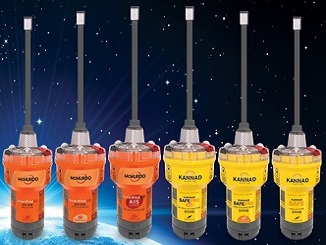 McMurdo, the most trusted name in emergency readiness and response and part of Orolia Group, today announced a new family of EPIRBs that will accelerate the search and rescue process by combining multiple frequencies into a single EPIRB product.
McMurdo, the most trusted name in emergency readiness and response and part of Orolia Group, today announced a new family of EPIRBs that will accelerate the search and rescue process by combining multiple frequencies into a single EPIRB product.
The McMurdo SmartFind and Kannad SafePro EPIRBs will be the world’s first distress beacons that can support each of the four frequencies used in the search and rescue process: 406MHz and 121.5MHz for beacon transmission; GNSS for location positioning; and AIS for localized connectivity. This multiple-frequency capability will ensure faster detection, superior positioning accuracy, greater signal reliability and ultimately, accelerated rescue of people or vessels in distress.
“With this announcement, we continue our long tradition of market leadership and product innovation in the maritime industry,” said Justine Heeley of McMurdo UK. “From GMDSS shipsets to AIS man overboard devices to personal locator beacons, and now with these latest EPIRB advancements, we are dedicated to developing state-of-the-art technologies that keep people safe while navigating our world’s waterways,” she added.
Global and Local Technology Convergence – The majority of today’s EPIRBs use 406MHz and 121.5MHz frequencies via satellite communication to provide location and positioning data to global search and rescue personnel who may be several hundred miles away. The additional AIS channels on the new McMurdo SmartFind G8 AIS and Kannad SafePro AIS EPIRBs will send position signal information to standard AIS electronic equipment on nearby vessels for complementary, local tracking and rescue capabilities. This global and local rescue capability will result in quicker signal detection and faster response times.
Expanded Satellite Connectivity – McMurdo SmartFind and Kannad SafePro EPIRBs have a multiple GNSS satellite constellation receiver supporting Galileo (once the Galileo constellation is fully operational), GPS and GLONASS – from a single beacon. Advanced GNSS data processing results in faster detection of positioning coordinates and enhances the accuracy of the emergency location.
Part of a Cohesive Ecosystem – The McMurdo SmartFind and Kannad SafePro EPIRBs are part of McMurdo’s comprehensive search and rescue ecosystem. As the world’s only provider of an end-to-end search and rescue ecosystem – including distress beacons, satellite ground stations, mission control and rescue coordination systems and rescue response products – McMurdo uniquely builds, integrates and tests products as part of a live search and rescue system. This ensures greater cohesion between distress signal transmission and reception so that beacon owners can feel confident that their signals will get to search and rescue authorities quickly.
MEOSAR Compatibility – The McMurdo SmartFind and Kannad SafePro EPIRBs are designed to be fully compatible with MEOSAR, the next generation of the Cospas-Sarsat international search and rescue satellite system that has helped to save over 40,000 lives since 1982. MEOSAR will increase the speed and accuracy of beacon signal detection and location with new MEOSAR ground network infrastructure and additional MEOSAR satellites. When fully deployed, a MEOSAR-compatible beacon can be located with an accuracy of location within 100 meters (328 feet), 95 percent of the time – and within five minutes of distress signal activation, all without reliance on GNSS. McMurdo currently manufactures approximately 50 percent of the world’s MEOSAR infrastructure and is also leading the design of additional MEOSAR-capable beacons under the European Union’s Horizon 2020 Research and Innovation Program’s HELIOS project.
“McMurdo’s new EPIRB announcement is a major step towards achieving a unified search and rescue vision,” said Bruce Reid, CEO of the International Maritime Rescue Federation. “The convergence of products and systems whether AIS and 406MHz or maritime domain awareness and search and rescue, respectively, will require a comprehensive understanding of the entire search and rescue ecosystem. I look forward to seeing more McMurdo solutions and innovations that will shape the search and rescue industry for years to come,” he added.
For more information about McMurdo emergency readiness and response solutions, visit the McMurdo web site.
